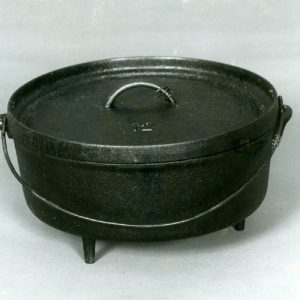calsfoundation@cals.org
Official State Cooking Vessel
aka: Dutch Oven
The Dutch oven was adopted as the state historic cooking vessel to indicate the significance of the vessel in the Arkansas’s history. Dutch ovens were brought into the state by the explorers and early settlers and were in wide use by the early 1800s. By the time of statehood, most homes probably had Dutch ovens in use on their fireplaces.
The Dutch oven is neither a pot nor a kettle. It is a cast iron vessel that has three legs to provide stable support and to provide space under the oven for coals to heat the oven from the bottom. The oven has a flat bottom and a tight-fitting lid to contain the heated pressure in the oven; the lid can be removed during cooking to observe or care for the cooking food. The oven has ears on two opposite places on the top of the sides, which allow it to be lifted by a bail or hooks. The sides of the oven usually have vertical walls with a smaller diameter at the bottom than the top. The lid has a rim around the edge to hold coals for additional heat.
Historians believe the earliest Dutch ovens were cast in Pennsylvania or Massachusetts, where iron ore and coal for heat in the processing of the cast iron were available. The creator’s name is not known, but the inventor was probably a cook in the early 1700s, someone who had a local foundry make the oven. It was so successful that high demand caused a rush of more ovens to be cast. While it is not known how the Dutch oven was named, English foundry owner Abraham Darby traveled to Holland to learn better casting methods and may have called them Dutch castings.
For centuries prior to the invention of the Dutch oven, most baking was done in brick or baked clay ovens. This required a large oven to be constructed in a family home or at a community site. Because of the Dutch oven’s size and build, preparation and cleaning became easier. Explorers, hunters, and settlers coming to Arkansas were also able to use Dutch ovens because of the better baking possibilities and the portability of the oven.
There were some variances on the design of the Dutch oven. Some pots or kettles had rounded bottoms, while others had flatter bottoms. Some kitchen ovens in later years are called Dutch ovens but are for use in a stove oven or on a stove top. “Camp Dutch oven” is a term often used to indicate the oven with a flat bottom, integral supporting legs, and the tight-fitting lid with a rim for containing coals. A loop was cast on the lid to allow lifting of the lid.
Dutch ovens were brought to Arkansas before statehood and were widely used in cooking on fireplace hearths. In the mid-1800s, wood-fired stoves were in use. By 1900, electric and gas-fired stoves were used in urban areas. Stoves caused the gradual decline in use of Dutch oven. However, by 1940, many campers were carrying and using Dutch ovens and caused a revival in interest in the utensil.
In the 2001 regular session of the Eighty-third General Assembly of the State of Arkansas, Senator Joseph K. Mahony, II introduced Senate Bill 402 to designate the Dutch oven as the official state historic cooking vessel. The Senate and the House approved the bill. It became Act 476 of 2001 and was signed by Governor Mike Huckabee on February 28, 2001.
For additional information:
Ragsdale, John G. Dutch Ovens Chronicled. Fayetteville, University of Arkansas Press, 1991.
Ware, David. It’s Official! The Real Stories behind Arkansas’s State Symbols. 2nd ed. Little Rock: Butler Center Books, 2017.
John G. Ragsdale
Little Rock, Arkansas
 Dutch Oven
Dutch Oven  Dutch Oven
Dutch Oven  Dutch Oven
Dutch Oven  Jodie Mahony
Jodie Mahony 



Comments
No comments on this entry yet.